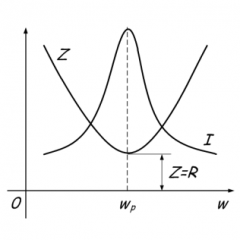What is electric capacitance and how is it measured
Definition
For conductors, an electric capacitance is a value that characterizes the body's ability to accumulate an electric charge. This is its physical meaning. It is denoted by the Latin letter C. It is equal to the ratio of charge to potential, if it is written in the form of a formula, the following is obtained:
C = q / f
The electric capacity of any object depends on its shape and geometric dimensions. If we consider a conductor in the shape of a ball, as an example, then the formula for calculating its value will look like:
This formula holds for a solitary conductor. If you place two conductors next to each other and separate them with a dielectric, then you get a capacitor. About this a little later, now let's look at what is measured electric capacity.
The unit of measurement of electric capacity is farad. If you decompose it into components according to the formula, then:
1 farad = 1 C / 1 V
Historically, the dimension of this unit has not been chosen correctly. The fact is that in practice you have to work with electric capacities: miles, micro, nano and picofarads. Which equals the fractions of a farad, namely:
1 mF = 10 ^ (- 3) Ф
1 μF = 10 ^ (- 6) F
1 nF = 10 ^ (- 9) Ф
1 pF = 10 ^ (- 12) Ф
Capacitors
A capacitor is two plates of conductive material located opposite each other, between which there is a dielectric layer. In the charged state, the plates have different potentials: one of them will be positive, and the second negative. The electric capacity of the capacitor depends on the magnitude of the charge on its plates and the potential difference, the voltage between them. An electrostatic field arises between the plates, which holds the charges on the plates. The formula for the capacitance of a capacitor in the general case:
C = q / U
In simple words, the capacitance of the capacitor depends on the area of the plates and the distance between them, as well as the relative dielectric constant of the material located between them. They are distinguished by the dielectric used:
- ceramic;
- film;
- mica;
- metal paper;
- electrolytic;
- tantalum, etc.
According to the shape of the plates:
- flat;
- cylindrical;
- spherical, etc.
Since the formula for the area of a figure depends on its shape, the formula for capacity will be different for each case.
For a flat capacitor:
For two concentric spheres with a common center:
For cylindrical capacitor:
Like other elements of the electric circuit, in this case there are two main ways of connecting capacitors: parallel and serial.
The final electrical capacitance of the resulting circuit depends on this. The calculations of the capacitance of several capacitors are reminiscent of the calculations of the resistance of resistors in different connections, only the formulas for the connection methods are located on the contrary, that is:
- When connected in parallel, the total electrical capacity of the circuit is the sum of the capacitances of each of the elements. Each next connected increases the total capacity
Ctotal = C1 + C2 + C3
- When connected in series, the electric capacity of the circuit decreases, like a decrease in resistance in a circuit of parallel-connected resistors. I.e:
Cot = (1 / C1) + (1 / C2) + (1 / C3)
Important! In a parallel circuit, the voltages on the plates of each element are the same. This is used to obtain large electrical capacities. In the series connection of two voltage elements on the plates of each of the capacitors is half the total voltage. For three, thirds, and so on.
Batteries and power consumption
The main characteristics of batteries are:
- Rated voltage.
- Capacity.
- Maximum discharge current.
In this case, to determine the quantitative characteristics of the operating time, or, in simple terms, to calculate how long the battery lasts, the capacity value is used.
In rechargeable batteries, the following dimensions are used to describe the electrical capacity:
- And * h - ampere-hours for large batteries, for example automobile.
- mAh - milliampere-hours, for batteries for wearable devices, such as smartphones, quadcopters and electronic cigarettes.
- W * hours - Watt hours.
These characteristics allow you to determine how long the battery will withstand under a specific load. To determine the electrical capacity of the battery is measured in pendants (C). In turn, the pendant is equal to the amount of electricity transferred to the battery at a current of 1A for 1s. Then if you translate into hours, then at a current of 1A for 1 hour, 3600 C are transmitted.
One way to measure the battery capacity is to discharge it with a known current, and you must measure the discharge time. Suppose, if the battery is discharged to the minimum voltage level in 10 hours with a current of 5A, then its capacity is 50 A * h
Electricity is an important quantity in electronics and electrical engineering. In practice, capacitors are used in almost every circuit of an electronic device. For example, in power supplies - to smooth out ripples, reduce the effect of high-voltage surges on power switches. During timing circuits of various circuits, as well as in PWM controllers in order to set the operating frequency. Batteries are also commonly used. In general, the problems of energy storage and phase shift are very common.
The provided video will help to study the issue in more detail:
A brief explanation is provided in this video tutorial:
Now you know what an electric capacitance is, in what units it is measured, and what this quantity depends on. We hope that the information provided was useful and understandable to you!
Related materials:










